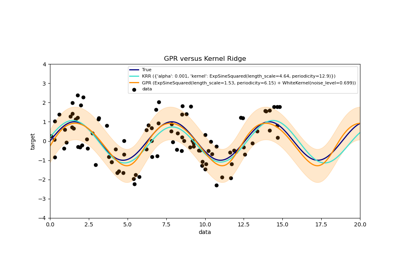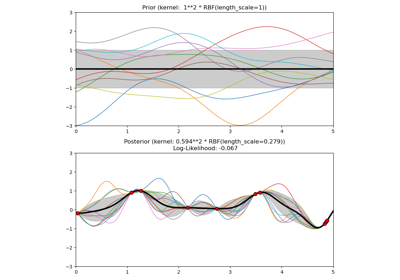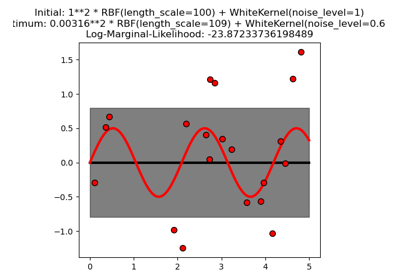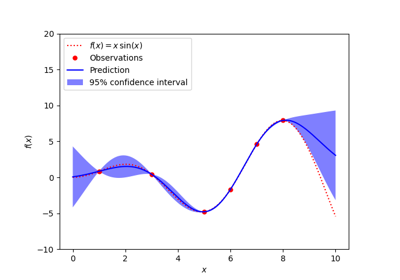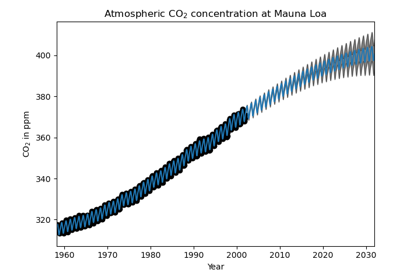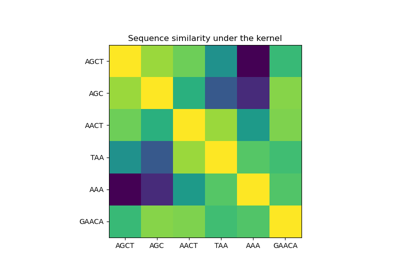sklearn.gaussian_process.GaussianProcessRegressor¶
-
class
sklearn.gaussian_process.GaussianProcessRegressor(kernel=None, *, alpha=1e-10, optimizer='fmin_l_bfgs_b', n_restarts_optimizer=0, normalize_y=False, copy_X_train=True, random_state=None)[source]¶ Gaussian process regression (GPR).
The implementation is based on Algorithm 2.1 of Gaussian Processes for Machine Learning (GPML) by Rasmussen and Williams.
In addition to standard scikit-learn estimator API, GaussianProcessRegressor:
allows prediction without prior fitting (based on the GP prior)
provides an additional method sample_y(X), which evaluates samples drawn from the GPR (prior or posterior) at given inputs
exposes a method log_marginal_likelihood(theta), which can be used externally for other ways of selecting hyperparameters, e.g., via Markov chain Monte Carlo.
Read more in the User Guide.
New in version 0.18.
- Parameters
- kernelkernel instance, default=None
The kernel specifying the covariance function of the GP. If None is passed, the kernel “1.0 * RBF(1.0)” is used as default. Note that the kernel’s hyperparameters are optimized during fitting.
- alphafloat or array-like of shape (n_samples), default=1e-10
Value added to the diagonal of the kernel matrix during fitting. Larger values correspond to increased noise level in the observations. This can also prevent a potential numerical issue during fitting, by ensuring that the calculated values form a positive definite matrix. If an array is passed, it must have the same number of entries as the data used for fitting and is used as datapoint-dependent noise level. Note that this is equivalent to adding a WhiteKernel with c=alpha. Allowing to specify the noise level directly as a parameter is mainly for convenience and for consistency with Ridge.
- optimizer“fmin_l_bfgs_b” or callable, default=”fmin_l_bfgs_b”
Can either be one of the internally supported optimizers for optimizing the kernel’s parameters, specified by a string, or an externally defined optimizer passed as a callable. If a callable is passed, it must have the signature:
def optimizer(obj_func, initial_theta, bounds): # * 'obj_func' is the objective function to be minimized, which # takes the hyperparameters theta as parameter and an # optional flag eval_gradient, which determines if the # gradient is returned additionally to the function value # * 'initial_theta': the initial value for theta, which can be # used by local optimizers # * 'bounds': the bounds on the values of theta .... # Returned are the best found hyperparameters theta and # the corresponding value of the target function. return theta_opt, func_min
Per default, the ‘L-BGFS-B’ algorithm from scipy.optimize.minimize is used. If None is passed, the kernel’s parameters are kept fixed. Available internal optimizers are:
'fmin_l_bfgs_b'- n_restarts_optimizerint, default=0
The number of restarts of the optimizer for finding the kernel’s parameters which maximize the log-marginal likelihood. The first run of the optimizer is performed from the kernel’s initial parameters, the remaining ones (if any) from thetas sampled log-uniform randomly from the space of allowed theta-values. If greater than 0, all bounds must be finite. Note that n_restarts_optimizer == 0 implies that one run is performed.
- normalize_yboolean, optional (default: False)
Whether the target values y are normalized, the mean and variance of the target values are set equal to 0 and 1 respectively. This is recommended for cases where zero-mean, unit-variance priors are used. Note that, in this implementation, the normalisation is reversed before the GP predictions are reported.
Changed in version 0.23.
- copy_X_trainbool, default=True
If True, a persistent copy of the training data is stored in the object. Otherwise, just a reference to the training data is stored, which might cause predictions to change if the data is modified externally.
- random_stateint or RandomState, default=None
Determines random number generation used to initialize the centers. Pass an int for reproducible results across multiple function calls. See :term:
Glossary <random_state>.
- Attributes
- X_train_array-like of shape (n_samples, n_features) or list of object
Feature vectors or other representations of training data (also required for prediction).
- y_train_array-like of shape (n_samples,) or (n_samples, n_targets)
Target values in training data (also required for prediction)
- kernel_kernel instance
The kernel used for prediction. The structure of the kernel is the same as the one passed as parameter but with optimized hyperparameters
- L_array-like of shape (n_samples, n_samples)
Lower-triangular Cholesky decomposition of the kernel in
X_train_- alpha_array-like of shape (n_samples,)
Dual coefficients of training data points in kernel space
- log_marginal_likelihood_value_float
The log-marginal-likelihood of
self.kernel_.theta
Examples
>>> from sklearn.datasets import make_friedman2 >>> from sklearn.gaussian_process import GaussianProcessRegressor >>> from sklearn.gaussian_process.kernels import DotProduct, WhiteKernel >>> X, y = make_friedman2(n_samples=500, noise=0, random_state=0) >>> kernel = DotProduct() + WhiteKernel() >>> gpr = GaussianProcessRegressor(kernel=kernel, ... random_state=0).fit(X, y) >>> gpr.score(X, y) 0.3680... >>> gpr.predict(X[:2,:], return_std=True) (array([653.0..., 592.1...]), array([316.6..., 316.6...]))
Methods
fit(X, y)Fit Gaussian process regression model.
get_params([deep])Get parameters for this estimator.
log_marginal_likelihood([theta, …])Returns log-marginal likelihood of theta for training data.
predict(X[, return_std, return_cov])Predict using the Gaussian process regression model
sample_y(X[, n_samples, random_state])Draw samples from Gaussian process and evaluate at X.
score(X, y[, sample_weight])Return the coefficient of determination R^2 of the prediction.
set_params(**params)Set the parameters of this estimator.
-
__init__(kernel=None, *, alpha=1e-10, optimizer='fmin_l_bfgs_b', n_restarts_optimizer=0, normalize_y=False, copy_X_train=True, random_state=None)[source]¶ Initialize self. See help(type(self)) for accurate signature.
-
fit(X, y)[source]¶ Fit Gaussian process regression model.
- Parameters
- Xarray-like of shape (n_samples, n_features) or list of object
Feature vectors or other representations of training data.
- yarray-like of shape (n_samples,) or (n_samples, n_targets)
Target values
- Returns
- selfreturns an instance of self.
-
get_params(deep=True)[source]¶ Get parameters for this estimator.
- Parameters
- deepbool, default=True
If True, will return the parameters for this estimator and contained subobjects that are estimators.
- Returns
- paramsmapping of string to any
Parameter names mapped to their values.
-
log_marginal_likelihood(theta=None, eval_gradient=False, clone_kernel=True)[source]¶ Returns log-marginal likelihood of theta for training data.
- Parameters
- thetaarray-like of shape (n_kernel_params,) default=None
Kernel hyperparameters for which the log-marginal likelihood is evaluated. If None, the precomputed log_marginal_likelihood of
self.kernel_.thetais returned.- eval_gradientbool, default=False
If True, the gradient of the log-marginal likelihood with respect to the kernel hyperparameters at position theta is returned additionally. If True, theta must not be None.
- clone_kernelbool, default=True
If True, the kernel attribute is copied. If False, the kernel attribute is modified, but may result in a performance improvement.
- Returns
- log_likelihoodfloat
Log-marginal likelihood of theta for training data.
- log_likelihood_gradientndarray of shape (n_kernel_params,), optional
Gradient of the log-marginal likelihood with respect to the kernel hyperparameters at position theta. Only returned when eval_gradient is True.
-
predict(X, return_std=False, return_cov=False)[source]¶ Predict using the Gaussian process regression model
We can also predict based on an unfitted model by using the GP prior. In addition to the mean of the predictive distribution, also its standard deviation (return_std=True) or covariance (return_cov=True). Note that at most one of the two can be requested.
- Parameters
- Xarray-like of shape (n_samples, n_features) or list of object
Query points where the GP is evaluated.
- return_stdbool, default=False
If True, the standard-deviation of the predictive distribution at the query points is returned along with the mean.
- return_covbool, default=False
If True, the covariance of the joint predictive distribution at the query points is returned along with the mean
- Returns
- y_meanndarray of shape (n_samples, [n_output_dims])
Mean of predictive distribution a query points
- y_stdndarray of shape (n_samples,), optional
Standard deviation of predictive distribution at query points. Only returned when
return_stdis True.- y_covndarray of shape (n_samples, n_samples), optional
Covariance of joint predictive distribution a query points. Only returned when
return_covis True.
-
sample_y(X, n_samples=1, random_state=0)[source]¶ Draw samples from Gaussian process and evaluate at X.
- Parameters
- Xarray-like of shape (n_samples, n_features) or list of object
Query points where the GP is evaluated.
- n_samplesint, default=1
The number of samples drawn from the Gaussian process
- random_stateint, RandomState, default=0
Determines random number generation to randomly draw samples. Pass an int for reproducible results across multiple function calls. See :term:
Glossary <random_state>.
- Returns
- y_samplesndarray of shape (n_samples_X, [n_output_dims], n_samples)
Values of n_samples samples drawn from Gaussian process and evaluated at query points.
-
score(X, y, sample_weight=None)[source]¶ Return the coefficient of determination R^2 of the prediction.
The coefficient R^2 is defined as (1 - u/v), where u is the residual sum of squares ((y_true - y_pred) ** 2).sum() and v is the total sum of squares ((y_true - y_true.mean()) ** 2).sum(). The best possible score is 1.0 and it can be negative (because the model can be arbitrarily worse). A constant model that always predicts the expected value of y, disregarding the input features, would get a R^2 score of 0.0.
- Parameters
- Xarray-like of shape (n_samples, n_features)
Test samples. For some estimators this may be a precomputed kernel matrix or a list of generic objects instead, shape = (n_samples, n_samples_fitted), where n_samples_fitted is the number of samples used in the fitting for the estimator.
- yarray-like of shape (n_samples,) or (n_samples, n_outputs)
True values for X.
- sample_weightarray-like of shape (n_samples,), default=None
Sample weights.
- Returns
- scorefloat
R^2 of self.predict(X) wrt. y.
Notes
The R2 score used when calling
scoreon a regressor usesmultioutput='uniform_average'from version 0.23 to keep consistent with default value ofr2_score. This influences thescoremethod of all the multioutput regressors (except forMultiOutputRegressor).
-
set_params(**params)[source]¶ Set the parameters of this estimator.
The method works on simple estimators as well as on nested objects (such as pipelines). The latter have parameters of the form
<component>__<parameter>so that it’s possible to update each component of a nested object.- Parameters
- **paramsdict
Estimator parameters.
- Returns
- selfobject
Estimator instance.

